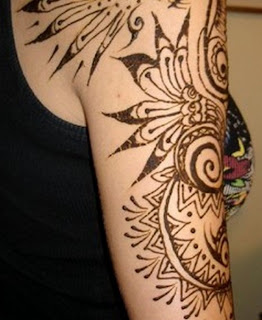Latest Arabic,Simple,Bridle,Body art,Asha Salva,Wedding dresses,Mehndi Cones Designs
Mehandi is the application of henna as a temporary form of skin decoration in India, Pakistan, Nepal, Bangladesh and the Maldives as well as by expatriate communities from those countries. The word mehndi is derived from the Sanskrit word mendhika.[1] The use of mehndi and turmeric is described in the earliest Hinduism's Vedic ritual books. Haldi (staining oneself with turmeric paste) as well as mehndi are Vedic customs, intended to be a symbolic representation of the outer and the inner sun. Vedic customs are centered around the idea of "awakening the inner light".
Traditional Indian designs are of representations of the sun on the palm, which, in this context, is intended to represent the hands and feet.
Latest Arabic,Simple,Bridle,Body art,Asha Salva,Wedding dresses,Mehndi Cones Designs
Mehndi decorations became fashionable in the West in the late 1990s, where they are sometimes called henna tattoos. Henna is typically applied during special occasions like weddings and Muslim festivals such as Eid-ul-Fitr and Eid-ul-Adha as well as in Hindu festivals like Karva Chauth, Diwali, Bhaidooj and Teej. In some Hindu festivals, many women have Henna applied to their hands and feet. It is usually drawn on the palms and feet, where the design will be clearest because the skin on these surfaces naturally contains less of the pigment melanin. Henna was originally used as a form of decoration mainly for brides.
In the modern age, usually people buy ready=made Henna cones, which are ready to use and make painting easy. However, in rural areas in India, women grind fresh henna leaves on grinding stones with added oil, which though not as refined as professionally prepared henna cones, brings much darker colors.
The term henna tattoo is figurative, because true tattoos are permanent surgical insertions of pigments underneath the skin, as opposed to pigments resting on the surface as is the case with mehndi.
Mehandi is the application of henna as a temporary form of skin decoration in India, Pakistan, Nepal, Bangladesh and the Maldives as well as by expatriate communities from those countries. The word mehndi is derived from the Sanskrit word mendhika.[1] The use of mehndi and turmeric is described in the earliest Hinduism's Vedic ritual books. Haldi (staining oneself with turmeric paste) as well as mehndi are Vedic customs, intended to be a symbolic representation of the outer and the inner sun. Vedic customs are centered around the idea of "awakening the inner light".
Traditional Indian designs are of representations of the sun on the palm, which, in this context, is intended to represent the hands and feet.
Latest Arabic,Simple,Bridle,Body art,Asha Salva,Wedding dresses,Mehndi Cones Designs
Mehndi decorations became fashionable in the West in the late 1990s, where they are sometimes called henna tattoos. Henna is typically applied during special occasions like weddings and Muslim festivals such as Eid-ul-Fitr and Eid-ul-Adha as well as in Hindu festivals like Karva Chauth, Diwali, Bhaidooj and Teej. In some Hindu festivals, many women have Henna applied to their hands and feet. It is usually drawn on the palms and feet, where the design will be clearest because the skin on these surfaces naturally contains less of the pigment melanin. Henna was originally used as a form of decoration mainly for brides.
In the modern age, usually people buy ready=made Henna cones, which are ready to use and make painting easy. However, in rural areas in India, women grind fresh henna leaves on grinding stones with added oil, which though not as refined as professionally prepared henna cones, brings much darker colors.
The term henna tattoo is figurative, because true tattoos are permanent surgical insertions of pigments underneath the skin, as opposed to pigments resting on the surface as is the case with mehndi.




























































No comments:
Post a Comment